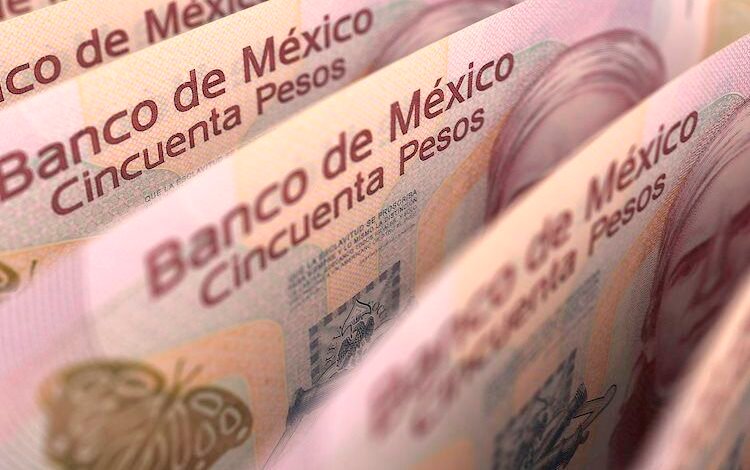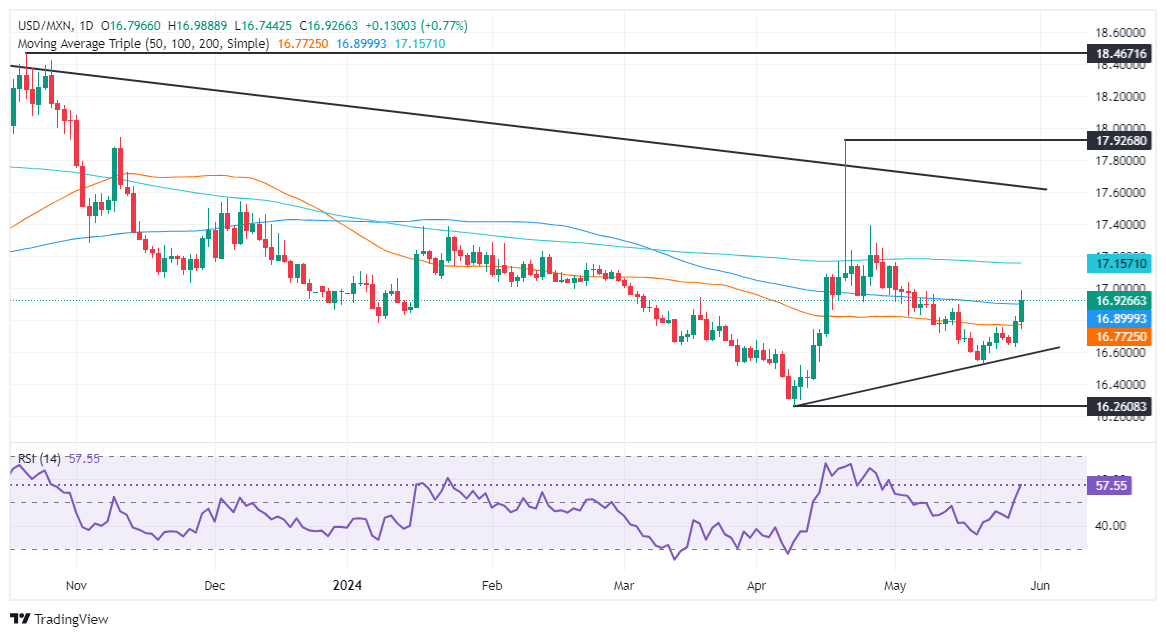Mexican Peso slumps against US Dollar ahead of Mexico’s general election

- Mexican Peso plummets sharply, posting losses of almost 1%.
- Investors reduce Peso exposure ahead of June 2 general election, favoring the Greenback.
- Upcoming PCE data and Mexico’s election results to dictate USD/MXN trajectory.
The Mexican Peso depreciated sharply against the US Dollar on Wednesday as US Treasury bond yields underpinned the Greenback. Investors began to turn cautious as Mexico’s general election loomed. The USD/MXN trades at 16.98 and gains more than 1%.
The Mexican currency is pressured due to a risk-off environment. Meanwhile, traders seem to be trimming their exposure to the Mexican Peso as Sunday, June 2, general election loom.
Most polls see Claudia Sheinbaum of Morena’s ruling party winning the presidential election. But Most analysts estimate that either way, Sheinbaum’s win or Xochitl Galvez’s surprise upset, both candidates are seen as market friendly.
Mexico’s economic schedule remains light, with just the release of the Unemployment Rate, the Fiscal Balance, and the Foreign Exchange Reserve for April toward the end of the week.
Across the border, US Treasury bond yields along the whole curve continued to climb for the second straight day amid a scarce economic docket. Regional Manufacturing Indices revealed by the Richmond and Dallas Fed were mixed, while investors waited for New York Fed President John Williams’s speech.
On Tuesday, Minneapolis Fed President Neel Kashkari was hawkish. He said that Fed officials hadn’t disregarded rate hikes, while adding that if they cut borrowing costs, it would be twice toward the end of 2024.
Meanwhile, traders brace for the release of April’s Personal Consumption Expenditures Price Index (PCE), the Federal Reserve’s (Fed) preferred inflation gauge. That, along with Mexico’s general election on Sunday, could dictate the USD/MXN path toward the second half of the year as the Mexican currency remains one of the strongest against the US Dollar.
Daily digest market movers: Mexican Peso drops on high US yields, Fed comments
- Last week’s data showed that Mexico’s economic outlook is turning uncertain as the mid-month headline inflation for May rose while underlying prices dipped.
- Mexico’s economic slowdown, as shown by the last Gross Domestic Product (GDP) report and a widening trade deficit, could exert pressure on Mexican Peso.
- May’s Citibanamex poll showed that most economists estimate Banxico will cut rates on June 27 from 11% to 10.75%. The median expects headline inflation at 4.21% and core at 4.07% in 2024.
- Mexico’s schedule will feature the Unemployment Rate, the Fiscal Balance, Foreign Exchange Reserves, and the general election on June 2.
- The Richmond Fed Manufacturing Index rose by 13 in May, exceeding April’s -10 contraction. The Services Index for the same period improved from -13 to 3.
- May’s Dallas Fed Services Index plunged from -12.1 to -10.6.
- In the week ahead, the US economic docket will feature the second estimate of Gross Domestic Product (GDP) for Q1 2024, unemployment claims for the last week, and the release of core PCE.
- Despite that, fed funds rate futures estimate just 24 basis points of easing toward the end of the year.
Technical analysis: Mexican Peso falls as USD/MXN climbs above 16.90
The USD/MXN downtrend remains intact, yet buyers are gathering steam as the pair tests the 100-day Simple Moving Average (SMA) at 16.76. Momentum shows that bulls are gaining traction as the Relative Strength Index (RSI) is about to pierce above the 50-midline to turn bullish.I
Buyers decisively surpassing the 100-day SMA at 16.70 could open the door for further gains. The next resistance would be the 50-day SMA at 16.89, the psychological figure at 17.00, and the 200-day SMA at 17.14.
On the other hand, a bearish continuation would happen if sellers keep the exchange rate below the 100-day SMA, which could pave the way for a dip to the 2023 low of 16.62, followed by the May 21 cycle low at 16.52 and the year-to-date low of 16.25.
Fed FAQs
Monetary policy in the US is shaped by the Federal Reserve (Fed). The Fed has two mandates: to achieve price stability and foster full employment. Its primary tool to achieve these goals is by adjusting interest rates. When prices are rising too quickly and inflation is above the Fed’s 2% target, it raises interest rates, increasing borrowing costs throughout the economy. This results in a stronger US Dollar (USD) as it makes the US a more attractive place for international investors to park their money. When inflation falls below 2% or the Unemployment Rate is too high, the Fed may lower interest rates to encourage borrowing, which weighs on the Greenback.
The Federal Reserve (Fed) holds eight policy meetings a year, where the Federal Open Market Committee (FOMC) assesses economic conditions and makes monetary policy decisions. The FOMC is attended by twelve Fed officials – the seven members of the Board of Governors, the president of the Federal Reserve Bank of New York, and four of the remaining eleven regional Reserve Bank presidents, who serve one-year terms on a rotating basis.
In extreme situations, the Federal Reserve may resort to a policy named Quantitative Easing (QE). QE is the process by which the Fed substantially increases the flow of credit in a stuck financial system. It is a non-standard policy measure used during crises or when inflation is extremely low. It was the Fed’s weapon of choice during the Great Financial Crisis in 2008. It involves the Fed printing more Dollars and using them to buy high grade bonds from financial institutions. QE usually weakens the US Dollar.
Quantitative tightening (QT) is the reverse process of QE, whereby the Federal Reserve stops buying bonds from financial institutions and does not reinvest the principal from the bonds it holds maturing, to purchase new bonds. It is usually positive for the value of the US Dollar.
Information on these pages contains forward-looking statements that involve risks and uncertainties. Markets and instruments profiled on this page are for informational purposes only and should not in any way come across as a recommendation to buy or sell in these assets. You should do your own thorough research before making any investment decisions. FXStreet does not in any way guarantee that this information is free from mistakes, errors, or material misstatements. It also does not guarantee that this information is of a timely nature. Investing in Open Markets involves a great deal of risk, including the loss of all or a portion of your investment, as well as emotional distress. All risks, losses and costs associated with investing, including total loss of principal, are your responsibility. The views and opinions expressed in this article are those of the authors and do not necessarily reflect the official policy or position of FXStreet nor its advertisers. The author will not be held responsible for information that is found at the end of links posted on this page.
If not otherwise explicitly mentioned in the body of the article, at the time of writing, the author has no position in any stock mentioned in this article and no business relationship with any company mentioned. The author has not received compensation for writing this article, other than from FXStreet.
FXStreet and the author do not provide personalized recommendations. The author makes no representations as to the accuracy, completeness, or suitability of this information. FXStreet and the author will not be liable for any errors, omissions or any losses, injuries or damages arising from this information and its display or use. Errors and omissions excepted.
The author and FXStreet are not registered investment advisors and nothing in this article is intended to be investment advice.




